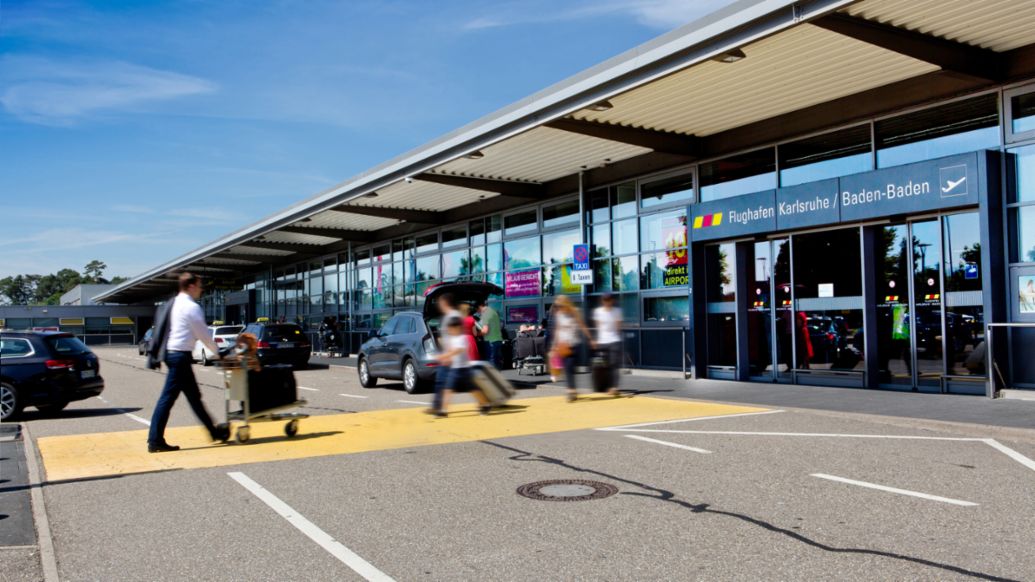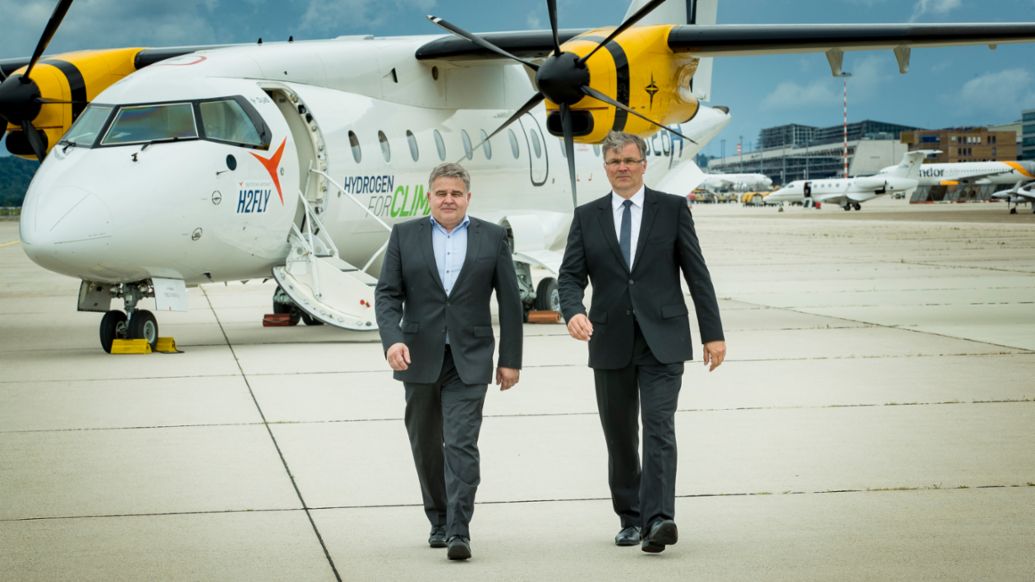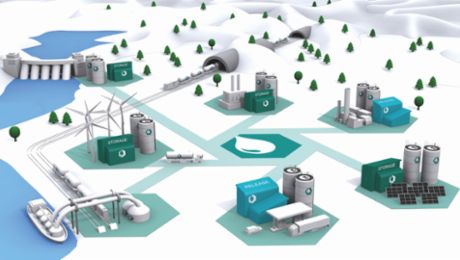It’s the year 2026 at Baden Airpark in southern Germany. Business travelers are especially pleased with this regional airport and the short distances to their flights. They leave their cars at charging stations right outside the terminal. A few minutes later—thanks to completely digitalized check-in processes—they are seated on a Dornier 328 powered by hydrogen fuel-cell technology. The electric airliner carries 40 passengers and has a range of 2,500 kilometers. Smaller electrified short-haul planes with 10, 20, or 30 seats and ranges of up to 1,500 kilometers connect Baden Airpark with other German and European regional airports. A vision has become reality: with small environmentally friendly planes, regional airports are successfully serving the niche market for business trips.
“With innovative business strategies, short-haul flights can continue to offer rapid connections.” Marc Landgraf, Partner at Porsche Consulting, expert in the field of aviation
Short-haul flights have been roundly criticized for some time now in light of efforts to reach climate targets. But the business world continues to depend on quick connections. Regional airports, which stimulate their local communities but in most cases have yet to operate economically and are therefore regarded with skepticism, could play a key role here. “With innovative business strategies, short-haul flights can continue to offer rapid connections,” says aviation expert Marc Landgraf from Porsche Consulting.

Around two dozen of Germany’s approximately 40 regional airports are potential hubs for new approaches to business travel. Examples include Rostock-Laage, Magdeburg-Cochstedt, Paderborn-Lippstadt, Bremen, Dortmund, Memmingen, and Karlsruhe/Baden-Baden. Easy access, quick check-in, and convenient size are three big advantages of these small facilities. However, regional airports have yet to achieve commercial success. As Landgraf explains, “Their capacities are often underutilized, and the high check-in and operating costs for small aircraft make it hard to achieve reasonable returns.” New business models are needed. And they’re already here: regional airports can focus on business travelers who can and want to avoid the big transport hubs. And if the right aircraft can make flying sustainable, short flights can be the key to economic success. Modern electric motors and increasingly powerful batteries are making this possible. According to Thorsten Ertel, an expert on Porsche Consulting’s sustainability team, “Regional airports can ideally serve many business travelers while also reducing emissions.”
“Business travelers save time, airports bring in more revenue, local communities enjoy higher tax proceeds, CO₂ emissions are lowered.” Thorsten Ertel, Senior Manager at Porsche Consulting, expert in the field of sustainability
No new airports have to be built for short-haul flights because enough already exist. With buildings and infrastructure already in place, there’s no need to pave over more soil. This is just one component of more sustainable aviation—which offers many additional benefits. Ertel lists some of them: “Business travelers save time, airports bring in more revenue, local communities enjoy higher tax proceeds, CO2 emissions are lowered.” Speaking of greenhouse gases, in 2019—the year before the Covid-19 pandemic broke out—Germany emitted more than 800 million tons. Short-haul flights of up to 1,500 kilometers accounted for 25 percent of Europe’s total aviation emissions. Politicians are calling for a change in course. “Hybrid-electric flights need to be the new standard in Germany by 2035,” says Thomas Jarzombek, the federal government’s coordinator of aviation and aerospace policy. But that’s not all. Noise levels, particularly at takeoff and landing, need to be lowered. But this too is possible. Electrified propellor aircraft are around 75 percent quieter than their elder “siblings” with turbine-powered engines.
“Hybrid-electric flights need to be the new standard in Germany by 2035.” Thomas Jarzombek , Federal government's coordinator of aviation and aerospace policy
Walter Schoefer, Managing Director and Management Spokesman for Flughafen Stuttgart GmbH and an advisory board member for Baden-Airpark GmbH, is convinced that regional airports are well-positioned to make the needed transition to greater sustainability. Regarding his regional airport situated between the Rhine River and the A5 freeway, he notes that “we have the space here to try out new approaches such as solar power systems and electric charging stations.” The latter have been almost entirely absent from aviation facilities throughout Germany. Nor have uniform standards for the associated charging infrastructure been instituted. There are also challenges regarding the maintenance of electric aircraft. A comprehensive network of maintenance stations is needed, along with specially trained personnel. Setting this up will take time and money. But the good news here is that maintenance for electric aircraft is comparable to that for electric cars—it’s simple and economical.

The German Aviation Association (BDL) views the role of electric aircraft primarily in terms of shuttle services to major airports. Regional airports would then serve to channel travelers to the big hubs. Electric VTOL aircraft—also known as air taxis—could offer an alternative here. The problem is that Europe has yet to standardize an authorization process for air taxis. The regional airports would also have to be better networked with other means of transportation. Germany’s only small airport with its own train station right now is Bodensee-Friedrichshafen.
“We have the space here to try out new approaches such as solar power systems and electric charging stations.” Walter Schoefer, Managing Director and Management Spokesman for Flughafen Stuttgart GmbH and an advisory board member for Baden-Airpark GmbH
Schoefer emphasizes that regional airports can only be commercially successful if they offer all forms of air travel: business, vacation, and individual flights. “The transformation to climate-friendly air travel will require considerable modifications on our part,” he notes. The changes will have to be introduced in parallel to normal operations—which hopefully will run smoothly during the transition. At the same time, he points to the enormous investments that regional airports will have to make. “It won’t be possible without partners,” he predicts. Airlines and energy companies could contribute, because airports in cities like Söllingen, Bielefeld, Lübeck, and other non-central regions represent potentially lucrative sources of business.
Electric aircraft on the runway
Established engine makers like Rolls-Royce are accelerating the development of electric drive systems for airplanes. Its engineers in Britain are currently developing the drivetrain for the P-Volt electric nine-seat aircraft for the Italian company Tecnam. Various smaller and younger companies also want to conquer the skies with sustainable drive concepts—especially for business travelers. Bavaria-based Deutsche Aircraft, for example, is planning to equip the legendary Dornier 328 short-haul passenger plane with an electric drive. It has signed a declaration of intent with H2Fly, a start-up and spin-off of the German Aerospace Center (DLR). The two companies will join forces in researching and developing hydrogen fuel-cell technology for regional commercial aircraft, and the first Dornier hydrogen demonstrator is expected to take off in 2025. The EU's Aviation Safety Agency (EASA) has already authorized the ultra-lightweight two-seat Velis Electro from Slovenian manufacturer Pipistrel. The Israeli-American start-up Eviation is developing an electric cargo aircraft called Alice, twelve of which have already been ordered by the DHL express delivery service. The eFlyer 800 under development at Bye Aerospace in Denver is expected to have eight seats and a peak speed of 600 km/h. In Scandinavia, small airlines such as Norway's Widerøe have been serving regional airports for years now. Even Finnair, a larger national airline, should soon be flying an electric propellor plane from the Swedish start-up Heart Aerospace.
Airports of the future
How can Porsche Consulting's aviation and sustainability experts help operators of regional airports chart a future-oriented course? "Whenever you work intensively on a project, it's always a good idea to have neutral specialists assess whether the technical and economic framework conditions make sense," observes Managing Director Schoefer. "These should be solid before pursuing the course at high speed." Aviation experts like Marc Landgraf, Partner at Porsche Consulting, are familiar with airports around in the world and can contribute experience from elsewhere and provide fresh impulses. "This expertise is enormously helpful," confirms Schoefer. Continuous and trust-based dialogue between project director and consultant is always important: "Listening is crucial." If the company doesn't quite fit the "suit" currently being tailored, "a good consultant has to tell me where I have to lose weight and which fitness program will promote future viability." The expenditure for this type of consultant is money well spent. "It will save you medical costs down the road."
Info
Text first published in Porsche Consulting Magazine.
-2.jpg/jcr:content/STR_HydrogenD328%20(1)%202.jpg)




